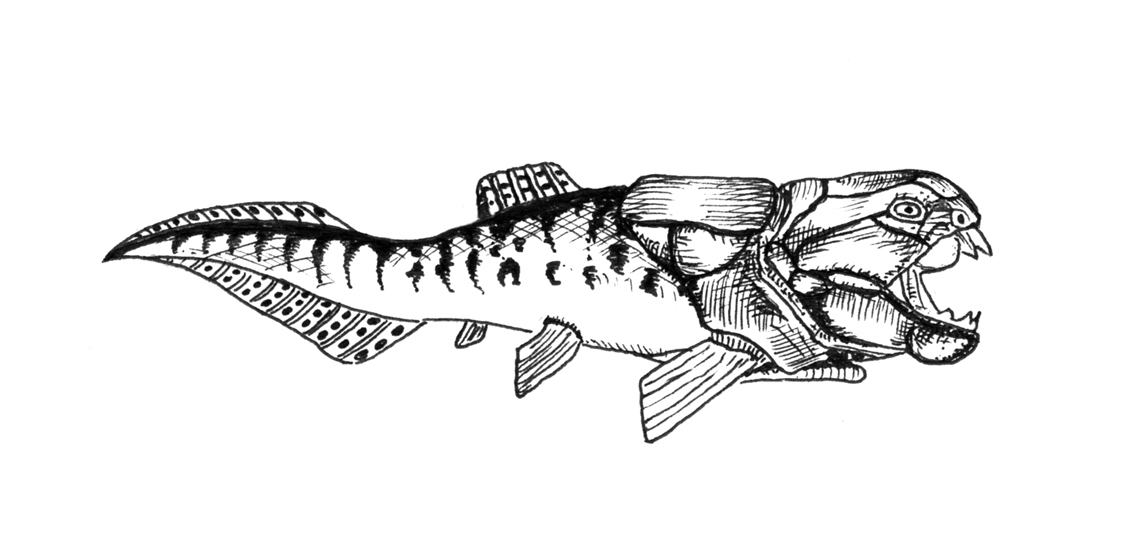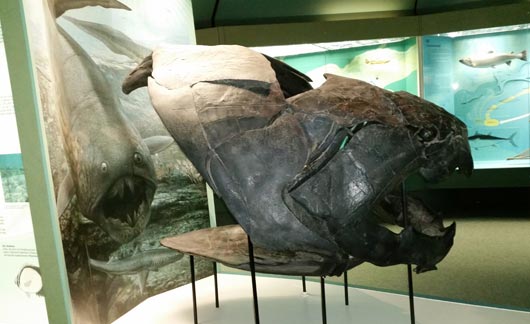Fans of Dunkleosteus et al
One of the questions in our inbox yesterday was from an avid dinosaur model collector who wanted to know apart from dinosaurs what were the other animals from the fossil record that we most admired. For example, what was our favourite fish fossil? An unusual question, one that led to much debate in the office but after a lengthy discussion we went for the placoderm Dunkleosteus, a huge predatory fish of the Devonian geological period.
The “Age of Fishes”
Often referred to as the “Age of Fishes” the Devonian featured an abundance of diverse vertebrate life forms in rivers, lakes, estuaries and in the sea. The group of fishes known as the “jawed fishes” evolved into a myriad of forms, ray-finned fish, lobe finned, lungfishes, the first sharks and the placoderms. It is from the jawed fish that the ancestors of the first land animals evolved.
An Illustration of the Huge Placoderm Dunkleosteus
Picture credit: Everything Dinosaur
The Placoderm Dunkleosteus
Placoderms, the correct term is Placodermi, were armoured fish that evolved in the Silurian, rapidly diversified to exploit a number of marine and freshwater environments during the Devonian before rapidly declining and becoming extinct at the end of this geological period. These jawed fishes had articulated armour on their heads and thorax.
Dunkleosteus was one of the largest of the placoderms, and at up to ten metres long, one of the largest fish known from Devonian strata. Although the body was not very streamlined, it was a nektonic (actively swimming), apex predator. Fossils of Dunkleosteus have been found in North America, Europe and North Africa. Some palaeontologists have estimated that larger specimens could have weighed more than four tonnes.
Powerful Jaws
The powerful jaws could be closed together like a pair of self-sharpening shears. This strange fish was formally named and described in 1873 by Dr John Newberry; the genus name is in honour of the famous American palaeontologist Dr David Dunkle of the Cleveland Museum of Natural History.
A number of museums have examples of Dunkleosteus fossils on display. The armoured head and thorax plates, some of which could be five centimetres thick; make a spectacular mounted exhibit in the fish gallery of natural history museums. There are large placoderm fossils on display at the London Natural History Museum as well as at the American Museum of Natural History and the Musee National d’Histoire Naturelle in Paris.
If you look carefully at the armoured plates you can see that on a number of these fossils there are deep scratches and puncture wounds. These are the scars indicating that Dunkleosteus did not always get its own way. The wounds would have been inflicted by prey items as they tried to defend themselves, or perhaps even the largest of these armoured fishes was hunted and predated upon.
Hunting Placoderms
What would hunt a four tonne, ten metre long prehistoric fish? Palaeontologists have speculated that these fishes may have been cannibals or that young fish may have been hunted by sharks.
A Museum Exhibit of the Placoderm Dunkleosteus
Picture credit: Everything Dinosaur
Safari Ltd of the United States created a superb, bronze-coloured Dunkleosteus model as part of the company’s Wild Safari Dinos prehistoric animal model range. It was introduced about five years ago and since it first came on the market it has proved very popular with prehistoric animal model collectors. It is certainly very desirable the Wild Safari Dinos Dunkleosteus model.
To view the extensive range of prehistoric animal models including Dunkleosteus available from Everything Dinosaur, click this link: Wild Safari Prehistoric World Figures.








Leave A Comment